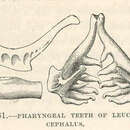Diagnostic Description
provided by Fishbase
Differs from its congeners in France, North, Baltic, Arctic, Black and Caspian Sea basins by the possession of the following characters: dorsal profile with a well-marked discontinuity between head and trunk; a row of black pigments along free margin of each flank scale, forming a regular reticulate pattern, with no or very few pigments on central part of scales; anal and pelvic fins orange to red; dorsal fin with 8½ branched rays; anal fin with 8½ branched rays (rarely 9½); scales on lateral line 40-45 + 2-3; mouth terminal, with well marked chin; lower jaw tip not included in the upper lip; interorbital distance 37-42% HL; postorbital distance 47-51% HL; eye diameter 17-22% HL, 1.5-2.3 times in snout length; body depth 22-27% SL; lower jaw long, length greater than depth of operculum; iris whitish; pharyngeal teeth 2,5-5,2; in stretched anal fin of individuals larger than about 15 cm SL, distance between tips of first and last branched rays usually greater than caudal peduncle depth (Ref. 59043). Caudal fin with 19 rays (Ref. 2196).
Life Cycle
provided by Fishbase
Spawning occurs in fast-flowing water above gravel bottom, rarely among submerged vegetation. Female spawn more than once during a season, individual females spawn with several males. Males assemble at spawning site and follow ripe females, often with much splashing, to shallow riffles. Females lays sticky eggs into the gravel (Ref. 59043). Pale yellow eggs are found attached to gravel, weed and stones in flowing water (Ref. 41678).
Migration
provided by Fishbase
Potamodromous. Migrating within streams, migratory in rivers, e.g. Saliminus, Moxostoma, Labeo. Migrations should be cyclical and predictable and cover more than 100 km.
- Recorder
- Crispina B. Binohlan
Morphology
provided by Fishbase
Dorsal spines (total): 3; Dorsal soft rays (total): 7 - 9; Analspines: 3; Analsoft rays: 7 - 10; Vertebrae: 42 - 48
Trophic Strategy
provided by Fishbase
Feeds on plants, invertebrates and detritus (Ref. 6258).
Biology
provided by Fishbase
Most abundant in small rivers and large streams of barbel zone with riffles and pools. Found along shores of slow-flowing lowland rivers, even in very small mountain streams, and in large lake, undertaking spawning migration to inflowing streams. Adults are solitary while juveniles occur in groups. Feeding larvae and juveniles live in very shallow shoreline habitats. Feed on a wide variety of aquatic and terrestrial animals and plant material. Large individuals prey predominantly on fishes. Breed in fast-flowing water above gravel bottom, rarely among submerged vegetation. Often form fertile hybrids with Alburnus alburnus (Ref. 59043). Popular with amateur sport fishermen. Can be caught with various baits and lures. The flesh is of poor quality (Ref. 38587).
- Recorder
- Crispina B. Binohlan
Importance
provided by Fishbase
fisheries: minor commercial; gamefish: yes
- Recorder
- Crispina B. Binohlan

